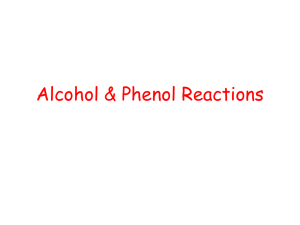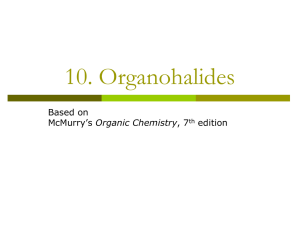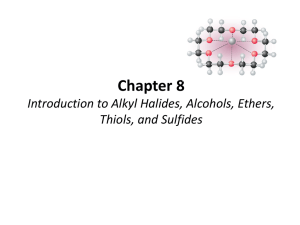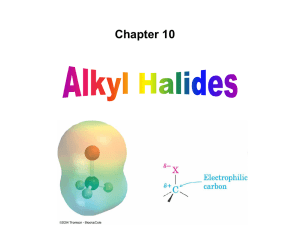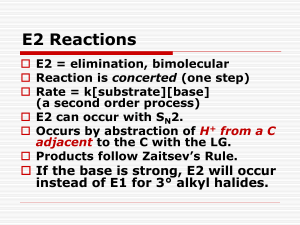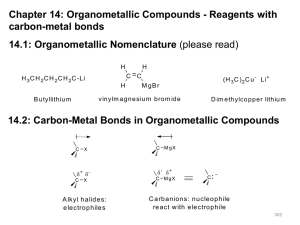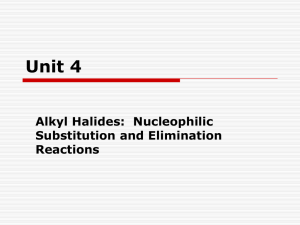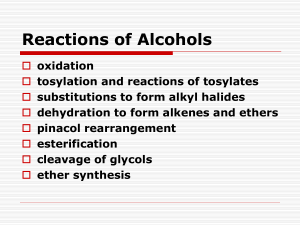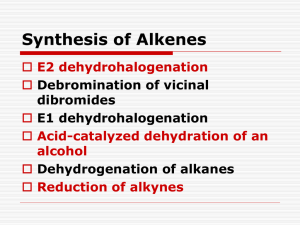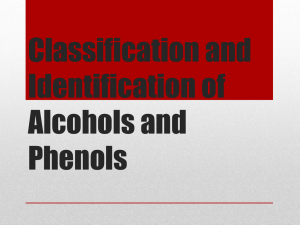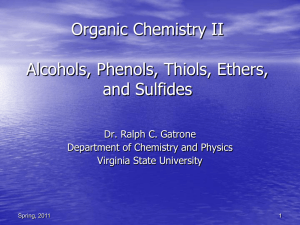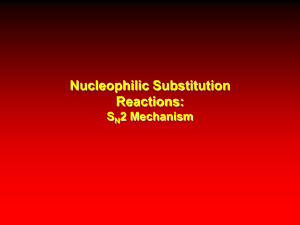4.5: Bonding in Alcohols and Alkyl Halides
advertisement
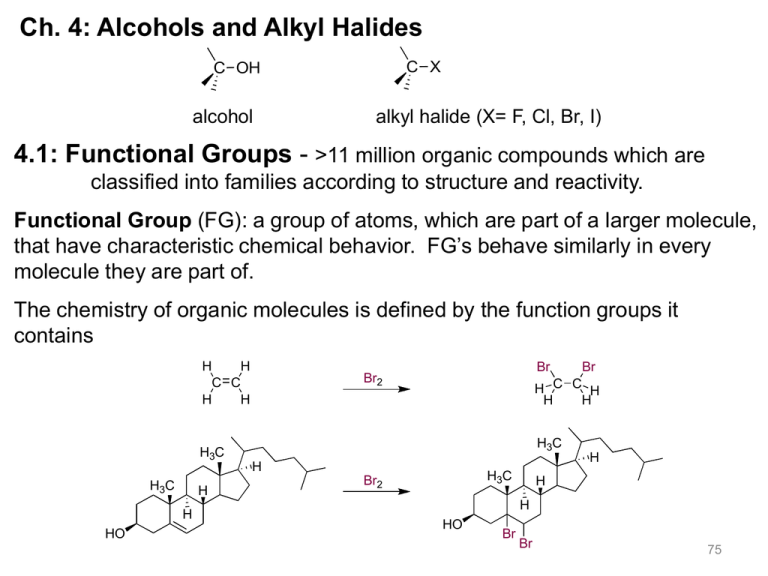
Ch. 4: Alcohols and Alkyl Halides C X C OH alcohol alkyl halide (X= F, Cl, Br, I) 4.1: Functional Groups - >11 million organic compounds which are classified into families according to structure and reactivity. Functional Group (FG): a group of atoms, which are part of a larger molecule, that have characteristic chemical behavior. FG’s behave similarly in every molecule they are part of. The chemistry of organic molecules is defined by the function groups it contains H H C C H H H3C H3C H H HO Br Br C C H H H H Br2 H3C H H3C Br2 H H H HO Br Br 75 C C Alkanes Carbon - Carbon Multiple Bonds Carbon-heteroatom single bonds basic C C C N C X Alkenes X= F, Cl, Br, I Alkyl Halide C C H C O O C N O amines nitro alkane C O C O C C ethers epoxide Alkynes alcohols H H C C C H C C C H H H acidic C S C C S S C sulfides (thioethers) disulfide C S thiols Arenes 76 Carbonyl-oxygen double bonds (carbonyls) Carbon-nitrogen multiple bonds acidic O H C aldehyde O O C O C imine (Schiff base) acid chloride O O C C ester ketones Cl C O C N H carboxylic acid O C basic O O C C N C anhydrides O C N amide 77 4.2: IUPAC Nomenclature of Alkyl Halides (please read) Use the systematic nomenclature of alkanes; treat the halogen as a substituent of the alkane. F- fluoro, Cl- chloro, Br- bromo, I- iodo 4.3: IUPAC Nomenclature of Alcohols 1. In general, alcohols are named in the same manner as alkanes; replace the -ane suffix for alkanes with an -ol for alcohols CH3CH2CH2CH3 CH3CH2CH2CH2OH OH butane 1-butanol 2-butanol 2. Number the carbon chain so that the hydroxyl group gets the lowest number 3. Number the substituents and write the name listing the substituents in alphabetical order. 78 Many alcohols are named using non-systematic nomenclature OH H3C OH OH C OH H3C H3C benzyl alcohol (phenylmethanol) allyl alcohol (2-propen-1-ol) HO tert-butyl alcohol (2-methyl-2-propanol) OH ethylene glycol (1,2-ethanediol) HO OH glycerol (1,2,3-propanetriol) 4.4: Classes of Alcohols and Alkyl Halides - Alcohols and alkyl halides are classified as according to the degree of substitution of the carbon bearing the halogen or -OH group OH primary (1°) : one alkyl substituent secondary (2°) : two alkyl substituents tertiary (3°) : three alkyl substituents 2-methyl-2-pentanol H H methanol H H H R 3-phenyl-2-butanol R C O C O C O H R R H OH H C O H 1¡ carbon 2¡ carbon primary secondary R R H 3¡ carbon tertiary 79 4.5: Bonding in Alcohols and Alkyl Halides - the C-X bond of alkyl halides and C-OH bond of alcohols has a significant dipole moment. H + C H - Cl H + + C H O H H = 1.9 H = 1.7 4.6: Physical Properties of Alcohols and Alkyl Halides: Intermolecular Forces H2O CH3CH2CH2CH3 MW=18 MW=58 bp= 100° C bp= -0° C C CH3CH2CH2CH2Cl MW=92.5 bp= 77° C CH3CH2Cl MW= 64.5 bp= 12° C CH3CH2CH2CH2OH MW=74 bp= 116° CH3CH2OH MW=60 bp= 78° C 80 Like water, alcohols can form hydrogen bonds: a non-covalent interaction between a hydrogen atom (+) involved in a polar covalent bond, with the lone pair of a heteroatom (usually O or N), which is also involved in a polar covalent bond (-) H O H O H O H H H O H O H O H H O N H C O - + O H - + N H + C O H H O H O H H H O H O H H O H H H H O H H H R O H C O H O R R O H H O R R O H O R Hydrogen-bonds are broken when the alcohol reaches its bp, which requires additional energy 81 4.7: Preparation of Alkyl Halides from Alcohols and Hydrogen Halides R-OH + H-X R-X + HOH Reactivity of the alcohol: H H C OH H Methyl << H R C OH H Primary (1°) < H R C OH R < R R C OH R Secondary (2°) Tertiary (3°) increasing reactivity Reactivity of the H-X : parallels the acidity of HX HF < HCl < HBr < HI 82 4.8: Mechanism of the Reaction of Alcohols with Hydrogen Halides Curved Arrow Convention 1. Curved arrows show the movement (flow) of electron during bond breaking and/or bond making processes. The foot of the arrow indicates where the electron or electron pair originates, the head of the arrow shows where the electron or electron pair ends up. . A. The movement of a single electron is denoted by a curved single headed arrow (fishhook or hook). double-headed arrow B. 2. The movement of an electron pair is denoted by a curved double headed arrow. If an electron pair moves in on a new atom, another electron pair must leave so that the atom does not exceed a full valance of eight electrons. There are two common exceptions: A. B. 3. single-headed arrow When an atom already has an incomplete valance (R3C+). With second row (or below) elements the octet rule may be violated. The arrows completely dictate the Lewis structure of the product. 83 Curved Arrow Convention Other Suggestions for Proper Arrow Pushing: 4. The natural polarization of double bonds between unlike atoms is in the direction of the more electronegative atom and this will be the important direction of electron movement. 5. In drawing a mechanism, the formal charges of atoms in the reactants may change in the product. Use your knowledge of Lewis structures and formal charge to determine this. 6. The first step in writing a mechanism is to identify the nucleophile (Lewis base) and the electrophile (Lewis acid). The first arrow is always from the nucleophile to the electrophile. The generally accepted mechanism for the reaction of t-butyl alcohol and HCl involves to give t-butyl chloride has three basic steps: 25°C (CH3)3CCl + H2O (CH3)3COH + HCl tert-Butyl tert-Butyl chloride alcohol 84 Mechanism: (CH3)3COH + HCl (CH3)3CCl + H2O 85 4.9: Potential Energy Diagrams for Multistep Reactions: The SN1 Mechanism The rate of oxonium ion formation is very fast The rate of carbocation formation (dissociation of the oxonium ion) is slow The rate of reaction between the carbocation and for X- is fast The overall rate is dependent of the slowest step (rate limiting step) rate = k [oxonium ion] , where k is the rate constant 86 4.10: Structure, Bonding, and Stability of Carbocations Carbocations are sp2 hybridized and have a trigonal planar geometry Substituents stabilize a carbocation through: a. Inductive Effects: shifting of electrons in a -bond in response to the electronegativity of a nearby atom (or group). Carbon is a good electron donor. Substitution can also stabilize carbocations by donating electron density through the -bond. R R C R + C R R R + C H 3°: three alkyl groups 2°: two alkyl groups donating electrons donating electrons H H + C H H + H 1°: one alkyl group methyl: no alkyl groups donating electrons donating electrons 87 b. Hyperconjugation: The C-H σ-bond on the neighboring carbon lines up with the vacant p-orbital and can donate electron density to the carbon cation. This is a “bonding” interaction and is stabilizing. More substituted carbocations have more possible hyperconjugation interactions. vacant p-orbital 4.11: Effect of Alcohol Structure on Reaction Rate. The order of reactivity for the reaction: R3C-OH + H-X R3C-X + HOH where 3° alcohols are most reactive and 1° alcohols are least reactive, reflects the stability of the intermediate carbocation. 88 The rate of a reaction is dependent of the activation energy (Eact) There is no formal relationship between Gact and G° What is the structure of a transition state? How can the structures of the reactants and products affect Gact The Hammond Postulate provides an intuitive relationship Between rate Gact) and product stability (G°). Typical reaction coordinate less common 89 The Hammond Postulate: The structure of the transition state more closely resembles the nearest stable species (i.e., the reactant, intermediate or product) For an endothermic reaction (G° > 0), the TS is nearer to the product. The structure of the TS more closely resembles that of the product. Therefore, factors that stabilize the product will also stabilize the TS leading to that product. For an exothermic reaction (G° < 0), the TS is nearer to the reactant. The structure of the TS more closely resembles that of the reactants. G°= 0 TS is halfway between reactant and products on the reaction coordinate G°> 0 TS lies closer to the products than the reactants on the reaction coordinate G°< 0 TS lies closer to the reactants than the products on the reaction coordinate 90 Fig. 4.16 91 4.12: Reaction of Primary Alcohols with Hydrogen Halides. The SN2 Mechanism: Methyl and primary carbocations are the least stable, and they are not likely to be intermediates in reaction mechanism RH2C-OH + H-X RH2C-X + HOH SN2 (substitution-nucleophilic-bimolecular). 92 4.13: Other Methods for Converting Alcohols to Alkyl Halides Preparation of alkyl chlorides by the treatment of alcohols with thionyl chloride (SOCl2) R-OH + SOCl2 + base R-Cl + SO2 + HCl Preparation of alkyl bromides by the treatment of alcohols with phosphorous tribromide (PBr3) R-OH + PBr3 R-Br + P(OH)3 These methods work best on primary and secondary alcohols. They do not work at all for tertiary alcohols 93 4.14: Halogenation of Alkanes R-H + X2 R-X + H-X Reactivity: F2 >> Cl2 > Br2 >> I2 4.15: Chlorination of Methane Mechanism of free radical halogenation has three distinct steps 1. Initiation 2. Propagation 3. Termination Free radical chlorination is not very useful for making alkyl chlorides: polychlorination, non-specific chlorination 94 4.16: Structure and Stability of Free Radicals Free radical: species that contain unpaired electrons O O Cl N O Organic (alkyl) radicals are usually highly reactive. The stability and structure of alkyl radicals parallels those of carbocations: H H C H < H R C H methyl < primary (1°) < R R C H < R R C R < secondary (2°) < tertiary (3°) Increasing stability H° (KJ/mol)= H H C H H H R C H H R R C H H R R C H R 435 410 397 380 Radicals are also stabilized by hyperconjugation 95 4.17: Mechanism of Chlorination of Methane Free-radical chain mechanism: 96 4.18: Halogenation of Higher Alkanes – free radical chlorination of more substituted carbons is favored, reflecting the stability of the intermediate radical. H H H H H C C C C H H H H H Cl2, h H H H H H C C C C Cl H H H H four 2° hydrogens six 1° hydrogens H H C H H H H C C C H H H H + H H Cl H H C C C C H H H H H (72 %) (28 %) Cl2, h H H C H H H H C C C Cl H H H one 3° hydrogens nine 1° hydrogens + H H C H H H H C C C H H Cl H (37 %) (63 %) Relative rates of free radical chlorination H R C H H Primary (1°) hydrogens 1.0 H R C H R < Secondary (2°) hydrogens 3.9 R R C H R < Tertiary (3°) hydrogens 5.2 97 Free radical bromination is highly selective H H C H H H H C C C H H H H Br2, h H H C H H H H C C C Br H H H H H C H H H H C C C H H Br H + 1 : 99 H R C H H Primary (1°) hydrogens 1.0 H R C H R < Secondary (2°) hydrogens 82 R R C H R < Tertiary (3°) hydrogens 1600 The propagation step for free radical bromination is endothermic, Whereas chlorination which is exothermic. According to the Hammond postulate the transition state for bromination should resemble the product radical, and therefore be more selective for the product going through the more stable radical intermediate 98
